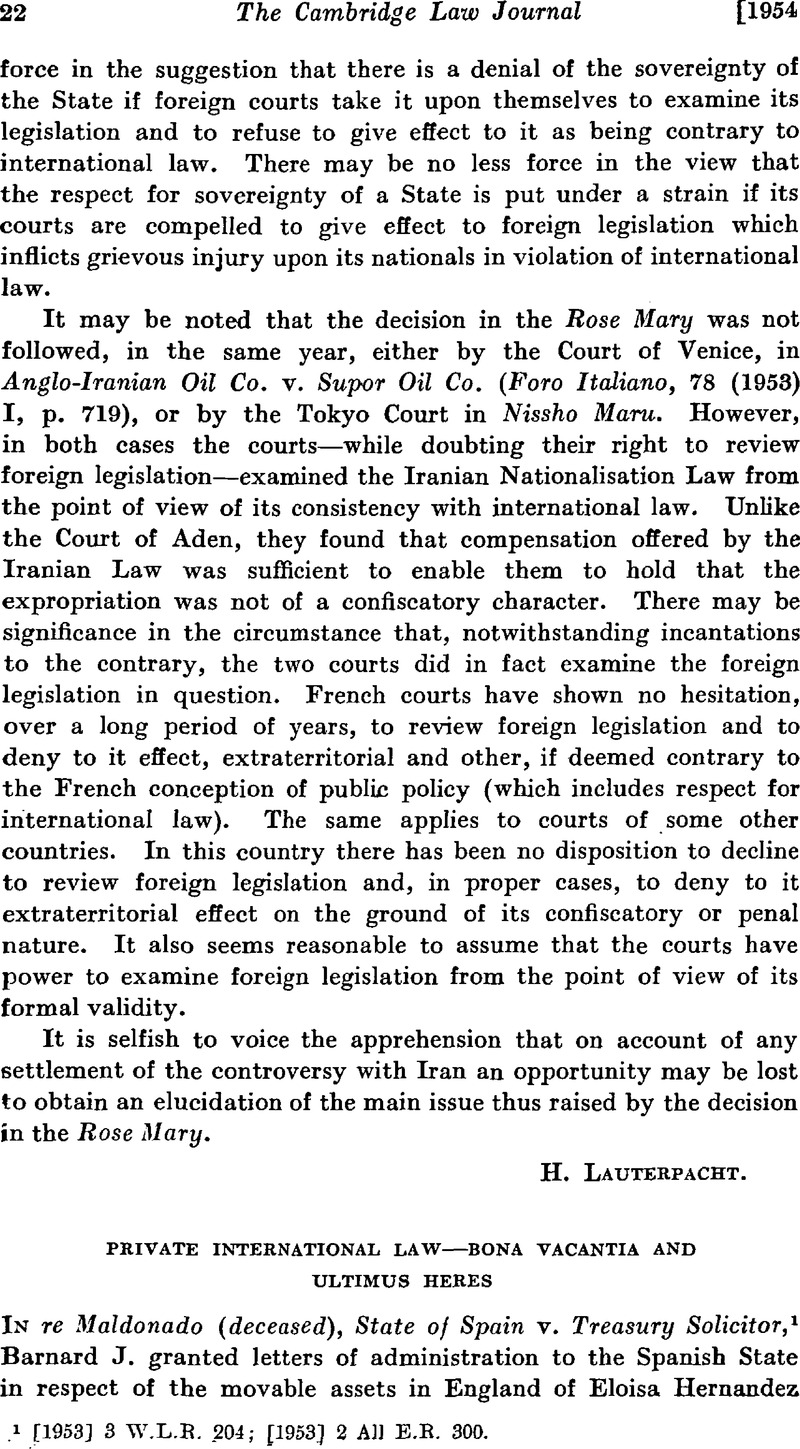Article contents
Private International Law—Bona Vacantia and Ultimus Heres
Published online by Cambridge University Press: 16 January 2009
Abstract

- Type
- Case and Comment
- Information
- Copyright
- Copyright © Cambridge Law Journal and Contributors 1954
References
1 [1953] 3 W.L.R. 204; [1953] 2 All E.R. 300.
2 [1902] 1 Ch. 847.
3 [1936] 2 All E.R. 1666.
4 [1954] 2 W.L.R. 64.
5 Dyke v. Walford (1846) 5 Moo.P.C. 434 at pp. 487 et seq.; Blackstone, , Commentaries II (15th ed. 1809), p. 494Google Scholar; Holdsworth, , History of English Law VII (1925), pp. 539, 495.Google ScholarRe Hole Estate (1948)Google Scholar 56 Manitoba R. 295, 301 et seq., Schröder, Lehrbuch der Deutschen Rechtsgeschichte (4th ed., 1902), pp. 195, 207, 334–5, 530.
6 Vangerow, , Lehrbuch der Pandekten II (7th ed., 1867), para. 564, p. 571Google Scholar; Dernburg, , Pandekten III (7th ed. 1903) para. 138, p. 269Google Scholar; but see Blume, , Rheinisches Museum für Jurisprudenz IV (1833), p 212Google Scholar, n. 6; Windscheid-Kipp, Lehrbuch des Pandektenrechts. (8th ed., 1901), para. 570, p. 330.
7 Gaius II, 150. Ulp.fragm. 28, 7.
8 Article 586. The previous codes of the Italian states did not treat the State as an heir. See Risso, , Rivista di diritto privato 8 (1938) 45, 57.Google Scholar See also article 760 of the Austrian Civil Code of 1811.
9 Article 956.
10 Article 1936.
11 Article 466.
12 Planiol, et Ripert, , Traité pratique de Droit Civil Français, IV (1928) No. 155, p. 189Google Scholar, with references. But see Code Civil, articles 768, 539, 713. For the Italian practice see Risso, loc. cit. at p. 68–70.
13 System des heutigen römischen Rechts, 8 (1849) para. 377 (9), p. 315.Google Scholar
14 For France see Planiol et Ripert, loc. cit., No. 158, p. 195; with references to literature and cases, Weiss, , Traité de droit international privé, IV (1910) pp. 564–67Google Scholar; Aubry, et Rau, , Cours de Droit Civil Français IX (1917) para. 606, p. 488.Google Scholar For Italy see Cavaglieri, Foro Italiano, 1922, I, 83; Cansacchi, La devoluzione dei beni vacanti allo stato, 1939. For Germany see Bar, , Theoric und Praxis des internationalen Privatrechts II (2nd ed. 1889) para. 387, p. 351Google Scholar; Lewald, Deutsches Internationales Privatrecht (1931) No. 368, p. 303. Hague Recueil 9 (1925), IV, pp. 84–88.
15 Private International Law (1945) para. 556, p. 591Google Scholar; para. 145, p. 157; (2nd ed.), para. 556, p. 579; para. 146, p. 157. Cf. Re Barnett's Trusts [1902] 1 Ch. 847, at p. 852Google Scholar (argument).
16 Conflict of Laws (6th ed., 1949) p. 818.Google Scholar
17 Beale, , Conflict of Laws II (1935), p. 1039Google Scholar, para. 309, 1, Goodrich, Conflict of Laws (3rd ed., 1949), p. 504, who draw only one distinction between claims of private individuals as successors and by the State as entitled to bona vacantia. See also In the Estate of Bell (1908) 52 S.J. 600.
18 Planiol et Ripert, loc. cit., No. 154, p. 188.
19 Enneccerus, , Lehrbuch des Bürgerlichen Rechts, vol. 5 (ed. Coing, ), para. 8, p. 38.Google Scholar
20 Escher, in Zürcher Kommentar zum Z. G. B. III, i (2nd ed., 1937), p. 78.Google Scholar
21 De Ruggiero-Maroi, Istituzioni di diritto privato (7th ed., 1948), para. 91, p. 418. Cass.Turin, March 11, 1922, Giurisprudenza Italiana, 1922, I, i. 407.Google Scholar
22 Batiffol, , Traité élémentaire de droit international privé (1949) No. 659, p. 662Google Scholar; see also Niboyet, , Traité de droit international privé français, IV (1944), No. 1207, p. 418.Google Scholar
23 Planiol et Ripert, loc. cit., No. 156, p. 191. This can be seen clearly from the attitude of the various legal systems towards life insurances taken out by the deceased for the benefit of his heir. The State takes the benefit always. See Planiol et Ripert, No. 155, p. 190. C. A. Paris, February 14, 1890, D. 91, 2.273; S. 91, 2.109. Ehrenzweig, , System des österreichischen allgemeinen Privatrechts, II, 2 (6th ed., 1924), para. 491, p. 372Google Scholar, II, 1 (3); Elfin in (1946) 36 Geo.L.J. 117–21, was not available.
24 Halsbury Laws of England (Hailsham ed.) Vol. 10, No. 880, p. 665; France: Planiol et Ripert, loc. cit., No. 156.
25 Austria: Ehrenzweig, loc cit., p. 371, II.
26 German Civil Code, paras. 1964 et seq.
27 Re Maldonado [1953] 2 All E.R. 300, at pp. 304, 305.
28 Swiss Civil Code, articles 592, 550, 555; German Civil Code, para. 2011.
29 Robertson, , Civil Proceedings by and against the Crown (1908), pp. 492Google Scholaret seq.; Enever, Bona Vacantia (1927). But see Re Hole Estate (1948), 56 Man.L.R. 295, at p. 315.Google Scholar
30 [1908] p. 46.
31 Compare the Ultimate Heir Act, 1921, Rev. Statutes of Alberta (1922), Chap. 144, amended 1929, chap. 11, and the observations of Lord Buckmaster in Att.-Gen. for Alberta v. Att.-Gen. for Canada [1928] A.C. 475. at p. 487. See also Mugdan, , Die gesamten Materialien zum Bürgerlichen Gesetzbuch für das Deutsche Reich, V (1899), p. 201Google Scholar; Motive, V, p. 379.
- 1
- Cited by




